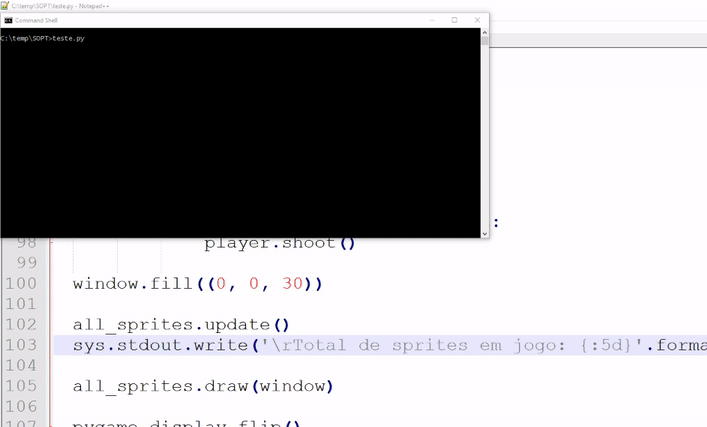1
Well, I’m trying to make a "ball" follow the rectangle of the game, but it doesn’t seem to be happening because the "ball" kind of blurs the screen when I move the player. I already looked for the solution of the problem and I found nothing.
Previously I had the same problem only only to draw a rectangle that moves and the problem was that I was using window.Fill(color) after drawing the rectangle. This time is not the case, even changing location the function does not happen anything.
import pygame
pygame.init()
isRunning = True
WIDTH = 800
HEIGHT = 600
FPS = 60
clock = pygame.time.Clock()
window = pygame.display.set_mode((WIDTH, HEIGHT))
class Player(pygame.sprite.Sprite):
def __init__(self):
pygame.sprite.Sprite.__init__(self)
self.image = pygame.Surface((60, 30))
self.image.fill((200, 255, 200))
self.rect = self.image.get_rect()
self.rect.centerx = WIDTH / 2
self.rect.bottom = HEIGHT - 30
def update(self):
self.speedx = 0
keystate = pygame.key.get_pressed()
if keystate[pygame.K_a]:
self.speedx = -5
if keystate[pygame.K_d]:
self.speedx = 5
self.rect.x += self.speedx
if self.rect.right + self.speedx > WIDTH:
self.rect.right = WIDTH
if self.rect.left + self.speedx < 0:
self.rect.left = 0
ball = Ball(self.rect.centerx, self.rect.top)
for i in all_sprites:
print(i)
all_sprites.add(ball)
def shoot(self):
ball = Ball(self.rect.centerx, self.rect.top)
all_sprites.add(ball)
balls.add(ball)
class Ball(pygame.sprite.Sprite):
def __init__(self, x, y):
pygame.sprite.Sprite.__init__(self)
self.image = pygame.Surface((10, 10))
self.image.fill((100, 150, 200))
self.rect = self.image.get_rect()
self.rect.bottom = y
self.rect.centerx = x
self.speedy = -3
def update(self):
pass
#self.rect.y += self.speedy
all_sprites = pygame.sprite.Group()
balls = pygame.sprite.Group()
player = Player()
all_sprites.add(player)
while isRunning:
clock.tick(FPS)
for event in pygame.event.get():
if event.type == pygame.QUIT:
isRunning = False
if event.type == pygame.KEYDOWN:
if event.key == pygame.K_SPACE:
player.shoot()
window.fill((0, 0, 30))
all_sprites.update()
all_sprites.draw(window)
pygame.display.flip()
pygame.quit()
quit()

So thanks for the answer, but that’s not exactly what I wanted in the end result. I asked the same question in Stack Overflow gringo and there explained to me that I was creating the instance and adding several times in the group and such, because then I was confusing the logic of the function " pygame.draw.rect(Surface, Color, (x, y, w, h))", which can be used in looping and will still delete itself, but with the group this has to be done manually (by code). Again, thank you for the time you took to explain it to me. I’ll leave the program link of the other Stack Overflow below
– Thiago1337
http://stackoverflow.com/questions/40834370/pygame-logic-issue/40838269?noredirect=1#comment68924361_40838269 .
– Thiago1337
A, and one more thing, my game goal is not to make a shooter but a Breakout or Brick Breaker, I had implemented this code "Shoot" just for testing.
– Thiago1337
For nothing. But, anyway, as you noticed, it’s hard to know what you need if you don’t explain it properly right? And, yes, I was led to believe that it wasn’t a ball because of the method
shoot. :) Good luck!– Luiz Vieira